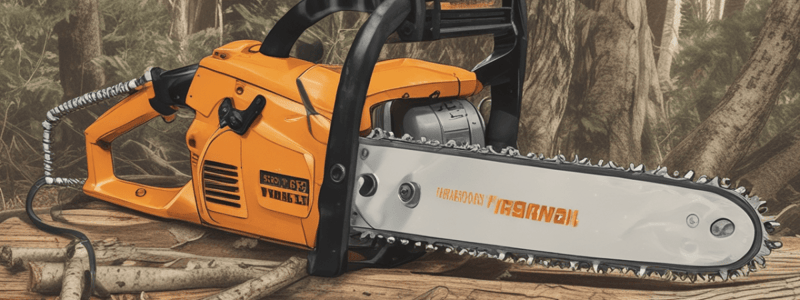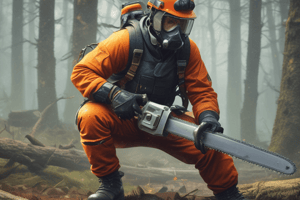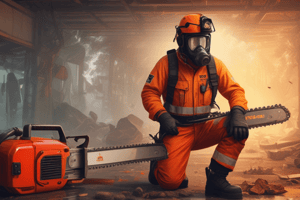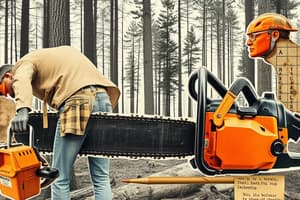Podcast
Questions and Answers
What percentage of the blade remaining indicates it should be replaced?
What percentage of the blade remaining indicates it should be replaced?
- 70%
- 90%
- 60%
- 80% (correct)
When should carbide tips be inspected for wear?
When should carbide tips be inspected for wear?
- Every week
- Every day
- Every hour
- Every shift (correct)
What type of cutting wheel is suitable for cutting railway tracks?
What type of cutting wheel is suitable for cutting railway tracks?
- Composite Abrasive Wheels
- Diamond Abrasive Wheels
- None of the above (correct)
- Steel Abrasive Wheels
What do the numerals on the side of a diamond cutting wheel indicate?
What do the numerals on the side of a diamond cutting wheel indicate?
What should be removed before cleaning the air filter?
What should be removed before cleaning the air filter?
In what direction should the tensioning nut point before tightening the V-belt?
In what direction should the tensioning nut point before tightening the V-belt?
What type of cutting wheel is suitable for both wet and dry applications?
What type of cutting wheel is suitable for both wet and dry applications?
How many carbide tips with 50% or more of the carbide missing can indicate the need for replacement?
How many carbide tips with 50% or more of the carbide missing can indicate the need for replacement?
What is the minimum thickness of steel that can be cut with a diamond abrasive wheel?
What is the minimum thickness of steel that can be cut with a diamond abrasive wheel?
What type of material cannot be cut with a Composite Abrasive Wheel?
What type of material cannot be cut with a Composite Abrasive Wheel?
Flashcards are hidden until you start studying
Study Notes
Introduction to Saws
- The St. John's Fire District uses gasoline-powered saws to support fire and rescue operations.
- Power saws are critical in providing support that will have a direct impact on tactical objectives.
Chainsaws
- Chainsaws are versatile tools used for Ventilation, Forcible Entry, and clearing downed trees.
- They are primarily used to cut through Class A roofing materials (wood and asphalt roof coverings) during vertical ventilation operations.
- The District mainly uses Stihl Chainsaws.
- Chainsaws are categorized into two types based on their primary use: General and Ventilation.
General Chainsaws
- Carried on all District fire apparatus.
- Used to clear roadways of downed trees.
- Standard configuration: 18-inch Bar with a standard chain.
- Designated saws with longer bars are used during significant weather events.
Ventilation Chainsaws
- Configured for ventilation operations.
- Manufactured specifically for the fire service and differ from regular chainsaws.
- Equipped with a specialized HD air filter.
- Feature a robust chain designed for rescue operations.
Safety Precautions
- Caution must be used when cutting through materials with a high-revving chain saw to avoid kickback.
- Kickback can cause serious injury.
- Properly hold and operate the saw to avoid kickback.
- Avoid using the saw above your head.
- Check the proper operation of the chain brake before starting the saw.
Chain Brake
- Engage the chain brake by pushing the black hand-guard on top of the saw towards the nose of the bar.
- Release the chain brake by pulling the hand-guard towards the hand-grip.
- The chain brake should always be engaged when the saw is stored.
Chain Tension
- Check the chain tension regularly.
- Adjust the chain tension by turning the tension-adjusting screw clockwise.
- Proper cold tension: As tight as possible without causing binding.
- Adjust the chain tension after the bar has cooled.
Replacing a Chain
- Loosen the bar retaining nuts and back off the bar adjusting screw.
- Remove the chain and reinstall it with the carbide teeth on top of the bar pointing towards the bar tip.
Flooded Saw Procedure
- If the saw won't start after attempting normal start procedures, it may be flooded.
- A flooded saw occurs when the combustion chamber has an excessive amount of unburned fuel.
- Follow the 2-person routine to start a flooded saw.
Fuel
- Most saw blades can be installed and cut in either direction.
- A used blade with less than 80% of the blade remaining should be replaced.
- Carbide tips should be inspected every shift for wear and replaced if 6 or more tips have 50% or more of the carbide missing.
Cutting Wheels
- There are several different cutting wheel blade types.
- Most saw blades are designed for a specific material to cut.
- Composite Abrasive Wheels are used for both wet and dry applications.
- Diamond Abrasive Wheels are suitable for wet cutting and can cut asphalt, concrete, stone, bricks, pipes, and iron.
Minor Maintenance
- Air Filter: Remove screws, clean the filter, and refit the filter cover.
- Tightening the V-belt: Loosen the nuts, point the tensioning nut towards the 0, and turn the tensioning clockwise approximately 1/8 turn.
Studying That Suits You
Use AI to generate personalized quizzes and flashcards to suit your learning preferences.




